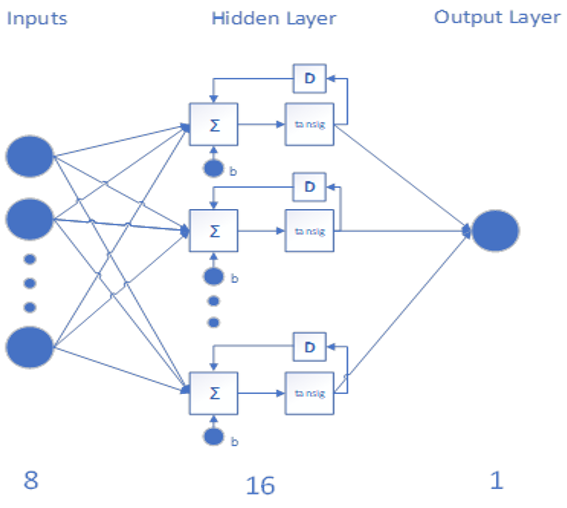Recurrent Neural Network Model for Short-term Electric Load Forecasting

Downloads
Accurate short-term electricity load forecasting is critical for planning power generation and maintaining cost efficiency. Since the amount of electricity generated significantly affects the cost-efficiency of power generation, a forecasting method with high accuracy is required. In response, this study developed a Recurrent Neural Network (RNN) model architecture trained using three different algorithms: Levenberg-Marquardt, Bayesian Regularization, and Scaled Conjugate Gradient. The model's performance was evaluated using the Mean Absolute Percentage Error (MAPE) metric. Historical load data were categorized by day type and divided into training and testing sets. The best-performing RNN model was used to carry out load forecasting, which was then compared to the forecasting results from PT PLN. Among the models tested, the RNN trained with Bayesian Regularization, configured with an 8-16-1 network architecture using a learning rate of 0.01 achieved the highest accuracy. In a two-week forecasting simulation, this model reached a MAPE of 1.4084%, significantly outperforming the 3.3160% error from PLN’s conventional forecasting method. These results underpin the effectiveness of RNNs, particularly when trained with Bayesian Regularization, for enhancing short-term electricity load forecasting within the scope of this dataset.
Downloads
[1] H. Zhu, Q. Lin, X. Li, H. Xiao, and T. Shao, “Short-term electrical load forecasting based on pattern label vector generation,” Energy Build, vol. 331, p. 115383, Mar. 2025, doi: 10.1016/J.ENBUILD.2025.115383.
[2] Z. Peng and X. Yang, “Short- and medium-term power load forecasting model based on a hybrid attention mechanism in the time and frequency domains,” Expert Syst Appl, vol. 278, p. 127329, Jun. 2025, doi: 10.1016/J.ESWA.2025.127329.
[3] S. H. Rafi, N. Al Masood, and S. R. Deeba, “An effective short-term load forecasting methodology using convolutional long short term memory network,” Proceedings of 2020 11th International Conference on Electrical and Computer Engineering, ICECE 2020, pp. 278–281, Dec. 2020, doi: 10.1109/ICECE51571.2020.9393067.
[4] H. Xu, Y. Zhang, and Y. Zhao, “Short-Term Electricity Load Forecasting Based on Ensemble Empirical Mode Decomposition and Long Short-Term Memory Neural Network,” Proceedings - 2023 IEEE International Conference on Energy Internet, ICEI 2023, pp. 271–275, 2023, doi: 10.1109/ICEI60179.2023.00058.
[5] W. T. Zheng, Q. Z. Wan, L. Zhu, N. Lv, and M. Li, “Short Term Power Load Forecasting Based on Clustering and Long Short Term Memory Network,” Proceedings of 2021 IEEE 4th International Electrical and Energy Conference, CIEEC 2021, May 2021, doi: 10.1109/CIEEC50170.2021.9510632.
[6] M. Xu, J. Dong, and X. Sun, “Optimization Research on Short-Term Power Load Forecasting Model Combining LSTM and Residual Networks,” 2025 2nd International Conference on Smart Grid and Artificial Intelligence (SGAI), pp. 1140–1144, Mar. 2025, doi: 10.1109/SGAI64825.2025.11009588.
[7] F. Li, X. Yu, X. Tian, and Z. Zhao, “Short-Term Load Forecasting for an Industrial Park Using LSTM-RNN Considering Energy Storage,” 2021 3rd Asia Energy and Electrical Engineering Symposium, AEEES 2021, pp. 684–689, Mar. 2021, doi: 10.1109/AEEES51875.2021.9403118.
[8] G. M. U. Din and A. K. Marnerides, “Short term power load forecasting using Deep Neural Networks,” 2017 International Conference on Computing, Networking and Communications, ICNC 2017, pp. 594–598, Mar. 2017, doi: 10.1109/ICCNC.2017.7876196.
[9] W. Waheed and Q. Xu, “Data-driven short term load forecasting with deep neural networks: Unlocking insights for sustainable energy management,” Electric Power Systems Research, vol. 232, p. 110376, Jul. 2024, doi: 10.1016/J.EPSR.2024.110376.
[10] S. A. H. Shah et al., “Improved electric load forecasting using quantile long short-term memory network with dual attention mechanism,” Energy Reports, vol. 13, pp. 2343–2353, Jun. 2025, doi: 10.1016/J.EGYR.2025.01.058.
[11] J. Tian, H. Liu, W. Gan, Y. Zhou, N. Wang, and S. Ma, “Short-term electric vehicle charging load forecasting based on TCN-LSTM network with comprehensive similar day identification,” Appl Energy, vol. 381, p. 125174, Mar. 2025, doi: 10.1016/J.APENERGY.2024.125174.
[12] P. B. Atosha, E. Özbilge, and Y. Kırsal, “Comparative Analysis of Deep Recurrent Neural Networks for Speech Recognition,” 32nd IEEE Conference on Signal Processing and Communications Applications, SIU 2024 - Proceedings, 2024, doi: 10.1109/SIU61531.2024.10600944.
[13] A. Wan, Q. Chang, K. AL-Bukhaiti, and J. He, “Short-term power load forecasting for combined heat and power using CNN-LSTM enhanced by attention mechanism,” Energy, vol. 282, Nov. 2023, doi: 10.1016/j.energy.2023.128274.
[14] T. Bashir, C. Haoyong, M. F. Tahir, and Z. Liqiang, “Short term electricity load forecasting using hybrid prophet-LSTM model optimized by BPNN,” Energy Reports, vol. 8, pp. 1678–1686, Nov. 2022, doi: 10.1016/j.egyr.2021.12.067.
[15] K. Y. Lee, Y. T. Cha, and J. H. Park, “Short-term load forecasting using an artificial neural network,” IEEE Transactions on Power Systems, vol. 7, no. 1, pp. 124–132, 1992, doi: 10.1109/59.141695.
[16] S. Ding, C. Su, and J. Yu, “An optimizing BP neural network algorithm based on genetic algorithm,” Artif Intell Rev, vol. 36, no. 2, pp. 153–162, Aug. 2011, doi: 10.1007/S10462-011-9208-Z.
[17] W. Jie-sheng and Z. Qing-wen, “Short-term Electricity Load Forecast Performance Comparison Based on Four Neural Network Models,” in The 27th Chinese Control and Decision Conference (2015 CCDC), IEEE, May 2015, pp. 2946–2950. doi: 10.1109/CCDC.2015.7162426.
[18] H. Park, B. Lee, J. Son, and H. Ahn, “A comparison of neural network-based methods for load forecasting with selected input candidates,” in 2017 IEEE International Conference on Industrial Technology (ICIT), IEEE, Mar. 2017, pp. 1100–1105. doi: 10.1109/ICIT.2017.7915516.
[19] L. Paranhos, “Predicting inflation with recurrent neural networks,” Int J Forecast, Mar. 2025, doi: 10.1016/J.IJFORECAST.2024.07.010.
[20] M. Szymkowiak, “Using recurrent neural networks to build a data-driven model of an autonomous underwater vehicle,” Transportation Research Procedia, vol. 83, pp. 417–424, Jan. 2025, doi: 10.1016/J.TRPRO.2025.03.008.
[21] Y. Chu, J. Fei, and S. Hou, “Adaptive Global Sliding-Mode Control for Dynamic Systems Using Double Hidden Layer Recurrent Neural Network Structure,” IEEE Trans Neural Netw Learn Syst, vol. 31, no. 4, pp. 1297–1309, Apr. 2020, doi: 10.1109/TNNLS.2019.2919676.
[22] P. Amos, S. Narendran, and M. Keerthivasan, “Analysis Of Traffic Sign Recognition Using Artificial Neural Network Algorithm Compared With Accuracy Of Recurrent Neural Networks,” 2024 9th International Conference on Applying New Technology in Green Buildings, ATiGB 2024, pp. 502–506, 2024, doi: 10.1109/ATIGB63471.2024.10717662.
[23] S. Mishra, R. Prusty, and P. K. Hota, “Analysis of Levenberg-Marquardt and Scaled Conjugate gradient training algorithms for artificial neural network based LS and MMSE estimated channel equalizers,” Proceedings - 2015 International Conference on Man and Machine Interfacing, MAMI 2015, no. Lm, 2016, doi: 10.1109/MAMI.2015.7456617.
[24] L. M. Saini and M. K. Soni, “Artificial neural network based peak load forecasting using Levenberg–Marquardt and quasi-Newton methods,” IEE Proceedings - Generation, Transmission and Distribution, vol. 149, no. 5, p. 578, 2002, doi: 10.1049/ip-gtd:20020462.
[25] B. G. Heydecker and J. Wu, “Identification of sites for road accident remedial work by Bayesian statistical methods: An example of uncertain inference,” Advances in Engineering Software, vol. 32, no. 10–11, pp. 859–869, 2001, doi: 10.1016/S0965-9978(01)00037-0.
[26] Z. Sun, Y. Chen, X. Li, X. Qin, and H. Wang, “A Bayesian regularized artificial neural network for adaptive optics forecasting,” Opt Commun, vol. 382, pp. 519–527, Jan. 2017, doi: 10.1016/J.OPTCOM.2016.08.035.
[27] J. L. Ticknor, “A Bayesian regularized artificial neural network for stock market forecasting,” Expert Syst Appl, vol. 40, no. 14, pp. 5501–5506, 2013, doi: 10.1016/j.eswa.2013.04.013.
[28] M. T. Hagan, H. B. Demuth, and M. H. Beale, Neural Network Design. Boston: PWS Publishing, 1996.
[29] M. Møller, “A scaled conjugate gradient algorithm for fast supervised learning,” 1993. doi: DOI: 10.1016/S0893-6080(05)80056-5.
[30] Q. Dong et al., “Short-Term Electricity-Load Forecasting by deep learning: A comprehensive survey,” Eng Appl Artif Intell, vol. 154, p. 110980, Aug. 2025, doi: 10.1016/J.ENGAPPAI.2025.110980.

This work is licensed under a Creative Commons Attribution-ShareAlike 4.0 International License.
The Authors submitting a manuscript do so on the understanding that if accepted for publication, copyright publishing of the article shall be assigned to Journal.



















